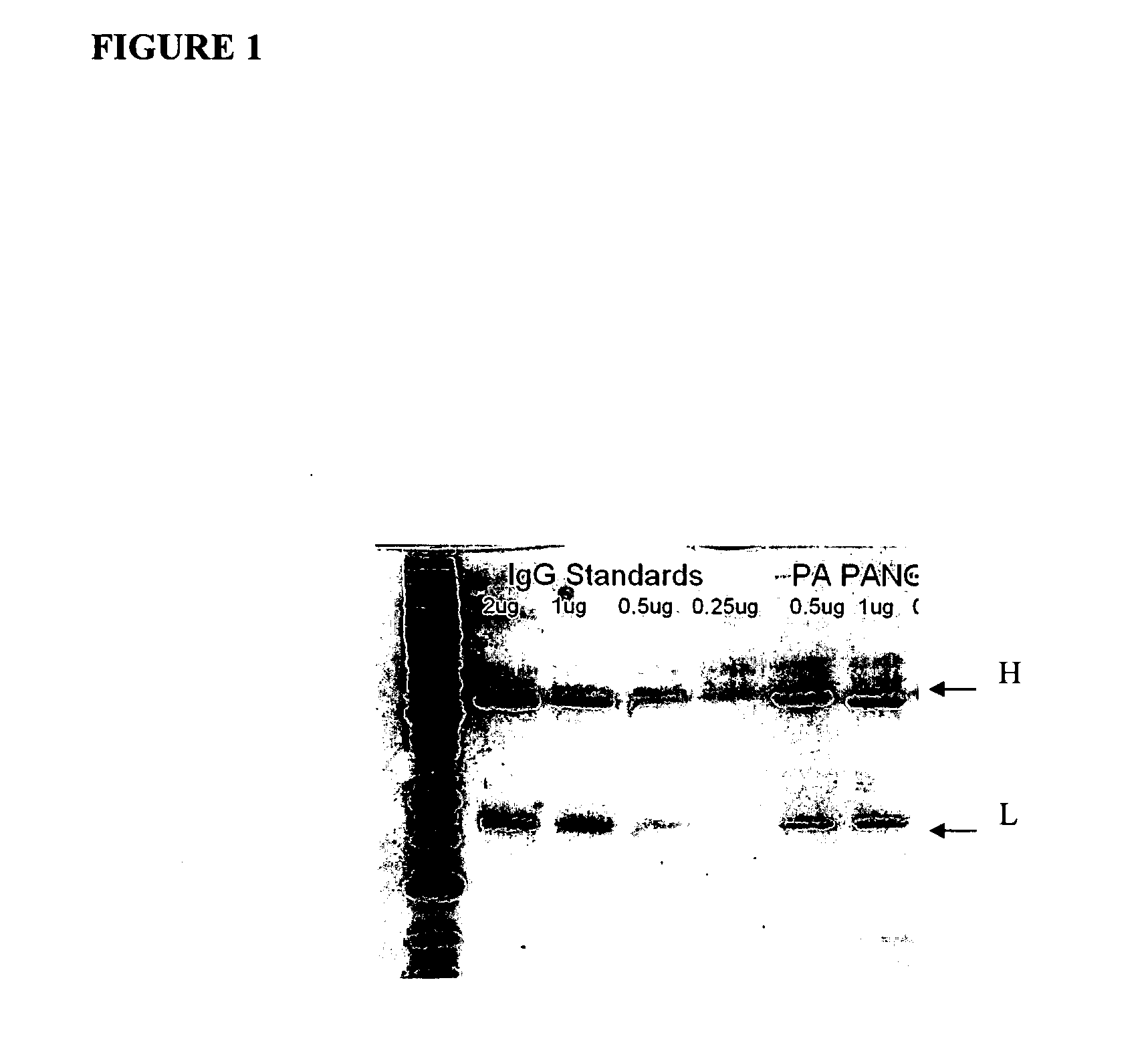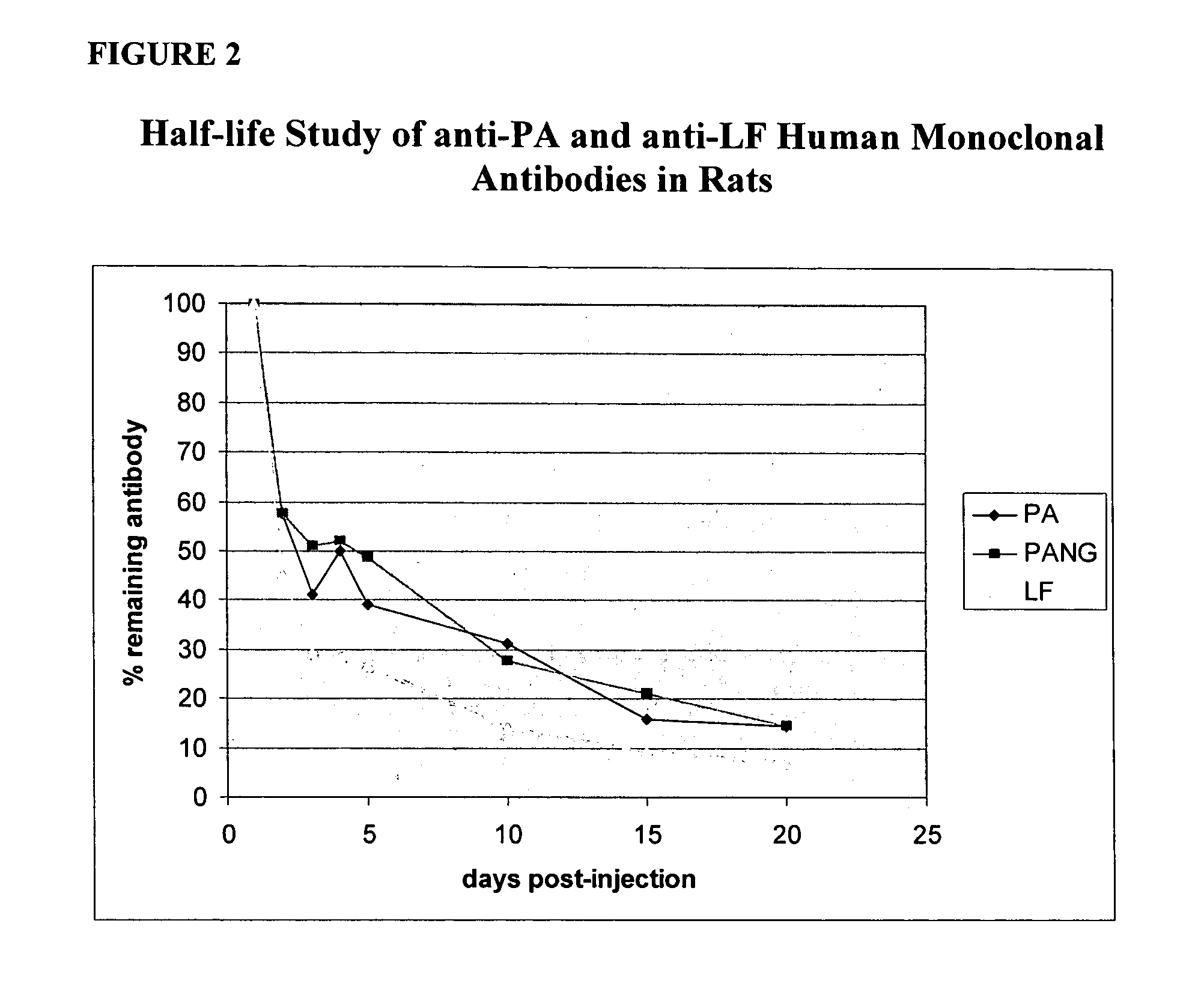Compositions and methods for production of immunoglobulins
a technology of immunoglobulin and immunoglobulin, which is applied in the field of immunoglobulin compositions and methods, can solve the problems of cell death, inability to definitively diagnose anthrax infection, and inability to provide resuscitation care, and achieve the effect of enhancing the binding activity of pa-1 or lf-1
- Summary
- Abstract
- Description
- Claims
- Application Information
AI Technical Summary
Benefits of technology
Problems solved by technology
Method used
Image
Examples
example 1
Isolation of cDNAs that Encode Human Monoclonal Antibodies from Hybridomas
[0118]This example describes use of certain of the oligonucleotide primers listed in Table 1 to isolate cDNAs encoding human monoclonal antibodies. All kits were used according to the manufacturer's directions.
[0119]RNA-Purification from Hybridoma Cell Lines.
[0120]Total RNA was purified from 105 cells of any given hybridoma cell line using the RNeasy Mini Kit (Qiagen). The RNA was eluted in 50 μl water (no yield was calculated) and 5 μl was used in each RT-PCR reaction.
[0121]Reverse Transcription-PCR.
[0122]The primers used for RT-PCR are listed in Table 1. RT-PCR was performed with Superscript One-Step RT-PCR with Platinum Taq DNA polymerase (Invitrogen). To efficiently target all possible variable regions in any given heavy or light chain sequence a combination of primers were used for each RT-PCR reaction and several RT-PCR reactions were performed simultaneously for amplification of each antibody gene.
[0123...
example 2
Construction of Vector pBISfi
[0132]This example describes modification of the binary vector pBI121 to facilitate its use for expression of antibodies in plants. First, the internal Sfi I site at 11031 by of vector pBI121 was mutagenized as follows: the vector was digested with Sfi I and the resulting single stranded overhangs were filled in using Klenow and the resulting blunt ends were re-ligated. To create a 5′ unique Sfi I site the oligonucleotides BamSfi 1 (5′-GATCCGGCCCAGCCGGCCG-3′; SEQ ID NO: 53) and BamSfi 2 (5′-GATCCGGCCGGCTGGGCCG-3′; SEQ ID NO: 54) were annealed to each other and ligated into the BamH I site of the vector pBI121 (lacking the internal Sfi I site). Similarly, annealing oligonucleotides SacSfi 1 (5′-GCCTCGGGGGCCGAGCT-3′; SEQ ID NO: 55) and SacSfi 2 (5′-GCCCCCGAGGCCGAGCT-3′; SEQ ID NO: 56) and ligating into the Sac I site of pBI121 (lacking the internal Sfi I site) created a 3′ unique Sfi I site.
example 3
Mutagenesis of cDNA Encoding PA Antibody Heavy Chain
[0133]The cDNA that encodes the PA gamma chain was mutagenized using Invitrogen's GeneTailor kit according to the manufacturer's recommendations so as to alter the N-glycosylation site at position 318 of the PA gamma chain. The following mutant primer was used: 5′-ccgcgggaggagcagtacCAAagcacgtaccgt-3′ (SEQ ID NO: 57). The reverse primer was: gtactgctcctcccgcggctttgtcttggca (SEQ ID NO: 58) As a result of the mutagenesis, the AAC codon was replaced by a CAA codon, resulting in an Asn->Gln alteration.
PUM
| Property | Measurement | Unit |
|---|---|---|
| nucleic acid | aaaaa | aaaaa |
| purity | aaaaa | aaaaa |
| half life studies | aaaaa | aaaaa |
Abstract
Description
Claims
Application Information
 Login to View More
Login to View More - R&D
- Intellectual Property
- Life Sciences
- Materials
- Tech Scout
- Unparalleled Data Quality
- Higher Quality Content
- 60% Fewer Hallucinations
Browse by: Latest US Patents, China's latest patents, Technical Efficacy Thesaurus, Application Domain, Technology Topic, Popular Technical Reports.
© 2025 PatSnap. All rights reserved.Legal|Privacy policy|Modern Slavery Act Transparency Statement|Sitemap|About US| Contact US: help@patsnap.com



